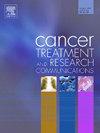Comparing the oncologic outcomes of breast-conserving surgery for breast cancer patients performed either upfront or following neoadjuvant chemotherapy: a matched retrospective cohort
IF 2.4
Q3 Medicine
引用次数: 0
Abstract
Background
Neoadjuvant chemotherapy (NACT) is used to reduce breast cancer size before surgery, allowing for breast conservation surgery (BCS) instead of mastectomy. However, concerns exist about higher positive margins and local recurrence rates.
Aims
This study compared the incidence of positive margins, local recurrence rates, and other oncologic outcomes of BCS performed either upfront or after NACT.
Methods
We conducted a retrospective matched cohort study of 122 patients treated at the American University of Beirut Medical Center between July 2011 and September 2016. Patients who underwent BCS whether upfront or after chemotherapy were matched 1:1 based on disease stage and molecular subtype.
Results
We matched 61 breast cancer patients treated with BCS following NACT to those treated with upfront BCS. Patients in the NACT group were younger, with a mean age of 45 years compared to 52 years in the upfront group. In the NACT group, 31 (51.7 %) have high-grade disease. Most patients received adjuvant radiation therapy. Positive margins were found in 14 patients in the NACT group and 5 in the upfront group (p = 0.03). Local recurrence was 8.6 % in the NACT group versus 1.7 % in the upfront group (p = 0.086). 5 years disease free survival was significantly lower 81 % in the NACT group versus 95 % in the upfront group (p = 0.03). Overall survival was not significantly different in the NACT group compared to the upfront group (p = 0.574).
Conclusion
Breast cancer treated with BCS after NACT has a low incidence of positive margins and similar oncologic outcomes compared to BCS performed upfront.
比较乳腺癌患者进行保乳手术前后新辅助化疗的肿瘤学结果:一个匹配的回顾性队列
背景:新辅助化疗(NACT)用于术前减小乳腺癌的体积,允许乳房保留手术(BCS)而不是乳房切除术。然而,存在较高的阳性边缘和局部复发率的担忧。目的:本研究比较了NACT前后BCS的阳性切缘发生率、局部复发率和其他肿瘤预后。方法对2011年7月至2016年9月在贝鲁特美国大学医学中心接受治疗的122例患者进行回顾性匹配队列研究。化疗前后接受BCS的患者根据疾病分期和分子亚型进行1:1匹配。结果我们将61例在NACT后接受BCS治疗的乳腺癌患者与接受BCS治疗的乳腺癌患者进行了配对。NACT组患者更年轻,平均年龄为45岁,而前期组为52岁。在NACT组中,31例(51.7%)有高度病变。大多数患者接受辅助放射治疗。NACT组有14例切缘阳性,而前期组有5例切缘阳性(p = 0.03)。NACT组局部复发率为8.6%,而术前组为1.7% (p = 0.086)。NACT组的5年无病生存率显著低于前者的81%,而前者为95% (p = 0.03)。NACT组的总生存率与术前组相比无显著差异(p = 0.574)。结论与术前行BCS相比,NACT后BCS治疗的乳腺癌阳性切缘发生率低,肿瘤预后相似。
本文章由计算机程序翻译,如有差异,请以英文原文为准。
求助全文
约1分钟内获得全文
求助全文
来源期刊

Cancer treatment and research communications
Medicine-Oncology
CiteScore
4.30
自引率
0.00%
发文量
148
审稿时长
56 days
期刊介绍:
Cancer Treatment and Research Communications is an international peer-reviewed publication dedicated to providing comprehensive basic, translational, and clinical oncology research. The journal is devoted to articles on detection, diagnosis, prevention, policy, and treatment of cancer and provides a global forum for the nurturing and development of future generations of oncology scientists. Cancer Treatment and Research Communications publishes comprehensive reviews and original studies describing various aspects of basic through clinical research of all tumor types. The journal also accepts clinical studies in oncology, with an emphasis on prospective early phase clinical trials. Specific areas of interest include basic, translational, and clinical research and mechanistic approaches; cancer biology; molecular carcinogenesis; genetics and genomics; stem cell and developmental biology; immunology; molecular and cellular oncology; systems biology; drug sensitivity and resistance; gene and antisense therapy; pathology, markers, and prognostic indicators; chemoprevention strategies; multimodality therapy; cancer policy; and integration of various approaches. Our mission is to be the premier source of relevant information through promoting excellence in research and facilitating the timely translation of that science to health care and clinical practice.
 求助内容:
求助内容: 应助结果提醒方式:
应助结果提醒方式:


